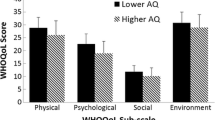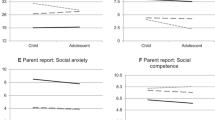Abstract
Recent research has begun to focus on the subclinical presentation of autistic-like traits in individuals, a construct termed the broader autism phenotype (BAP). The presence of the BAP has been established in both first-degree relatives of individuals with autism as well as in the general population. The current study aimed to examine how self-reported BAP characteristics, social interaction anxiety, and fear of negative evaluation relate to social functioning (specifically, loneliness) in a sample of college students. Results showed that for all subjects, BAP, social interaction anxiety, and fear of negative evaluation did not predict loneliness in a regression model. However, for males these predictors accounted for approximately 48 % of the variance in loneliness scores. Among males, individuals rating themselves as having lower social skills, lower imagination, and higher social interaction anxiety were more likely to also report feeling lonely. These results indicate that the predictors used may function differently among males and females. Although BAP characteristics and social interaction anxiety may not be important correlates of social functioning for females in this sample, they appear to be very important for males’ subjective feelings of loneliness.
Similar content being viewed by others
References
American Psychiatric Association. (2013). Diagnostic and statistical manual of mental disorders (5th ed.). Arlington: American Psychiatric Publishing.
Austin, E. J. (2005). Personality correlates of the broader autism phenotype as assessed by the Autism Spectrum Quotient (AQ). Personality and Individual Differences, 38(2), 451–460. doi:10.1016/j.paid.2004.04.022.
Baron-Cohen, S., Wheelwright, S., Skinner, R., Martin, J., & Clubley, E. (2001). The Autism-Spectrum Quotient (AQ): evidence from asperger syndrome/high-functioning autism, males and females, scientists and mathematicians. Journal of Autism and Developmental Disorders, 31(1), 5–17. doi:10.1023/A:1005653411471.
Bolton, P. P., Macdonald, H. H., Pickles, A. A., & Rios, P. P. (1994). A case-control family history study of autism. Journal of Child Psychology and Psychiatry, 35(5), 877–900. doi:10.1111/j.1469-7610.1994.tb02300.x.
Cacioppo, J. T., Hawkley, L. C., & Thisted, R. A. (2010). Perceived social isolation makes me sad: 5-year cross-lagged analyses of loneliness and depressive symptomatology in the Chicago health, aging, and social relations study. Psychology and Aging, 25(2), 453–463. doi:10.1037/a0017216.
Constantino, J. N., & Todd, R. D. (2003). Autistic traits in the general population: a twin study. Archives of General Psychiatry, 60(5), 524–530. doi:10.1001/archpsyc.60.5.524.
Dalton, K. M., Nacewicz, B. M., Alexander, A. L., & Davidson, R. J. (2007). Gaze-fixation, brain activation, and amygdala volume in unaffected siblings of individuals with autism. Biological Psychiatry, 61(4), 512–520. doi:10.1016/j.biopsych.2006.05.019.
Eagle, R. F., Romanczyk, R. G., & Lenzenweger, M. F. (2010). Classification of children with autism spectrum disorders: a finite mixture modeling approach to heterogeneity. Research in Autism Spectrum Disorders, 4(4), 772–781. doi:10.1016/j.rasd.2010.02.001.
Elsabbagh, M., Volein, A., Holmboe, K., Tucker, L., Csibra, G., Baron-Cohen, S., et al. (2009). Visual orienting in the early broader autism phenotype: disengagement and facilitation. Journal of Child Psychology and Psychiatry, 50(5), 637–642. doi:10.1111/j.1469-7610.2008.02051.x.
Folstein, S., & Rutter, M. (1977). Infantile autism: a genetic study of 21 twin pairs. Journal of Child Psychology and Psychiatry, 18(4), 297–321. doi:10.1111/j.1469-7610.1977.tb00443.x.
Fombonne, E. E., Bolton, P. P., Prior, J. J., Jordan, H. H., & Rutter, M. M. (1997). A family study of autism: cognitive patterns and levels in parents and siblings. Journal of Child Psychology and Psychiatry, 38(6), 667–683. doi:10.1111/j.1469-7610.1997.tb01694.x.
Hurley, R. E., Losh, M., Parlier, M., Reznick, J., & Piven, J. (2007). The broad autism phenotype questionnaire. Journal of Autism and Developmental Disorders, 37(9), 1679–1690. doi:10.1007/s10803-006-0299-3.
Jobe, L. E., & White, S. (2007). Loneliness, social relationships, and a broader autism phenotype in college students. Personality and Individual Differences, 42(8), 1479–1489. doi:10.1016/j.paid.2006.10.021.
Kashdan, T. B. (2002). Social anxiety dimensions, neuroticism, and the contours of positive psychological functioning. Cognitive Therapy and Research, 26(6), 789–810. doi:10.1023/A:1021293501345.
Leary, M. R. (1983). A brief version of the fear of negative evaluation scale. Personality and Social Psychology Bulletin, 9(3), 371–375. doi:10.1177/0146167283093007.
Luo, Y., Hawkley, L. C., Waite, L. J., & Cacioppo, J. T. (2012). Loneliness, health, and mortality in old age: a national longitudinal study. Social Science & Medicine, 74(6), 907–914. doi:10.1016/j.socscimed.2011.11.028.
MacKenzie, M. B., & Fowler, K. F. (2013). Social anxiety disorder in the Canadian population: exploring gender differences in sociodemographic profile. Journal of Anxiety Disorders, 27(4), 427–434. doi:10.1016/j.janxdis.2013.05.006.
Mattick, R. P., & Clarke, J. (1998). Development and validation of measures of social phobia scrutiny fear and social interaction anxiety. Behaviour Research and Therapy, 36(4), 455–470. doi:10.1016/S0005-7967(97)10031-6.
Murphy, M. M., Bolton, P. F., Pickles, A. A., Fombonne, E. E., Piven, J. J., & Rutter, M. M. (2000). Personality traits of the relatives of autistic probands. Psychological Medicine: A Journal of Research in Psychiatry and the Allied Sciences, 30(6), 1411–1424. doi:10.1017/S0033291799002949.
Newschaffer, C. J., Croen, L. A., Daniels, J., Giarelli, E., Grether, J. K., Levy, S. E., et al. (2007). The epidemiology of autism spectrum disorder. Annual Review of Public Health, 28, 235–258. doi:10.1146/annurev.publhealth.28.021406.144007.
Rettew, D. C. (2000). Avoidant personality disorder, generalized social phobia, and shyness: putting the personality back into personality disorders. Harvard Review of Psychiatry, 8(6), 283–297. doi:10.1093/hrp/8.6.283.
Russell, D. W. (1996). UCLA loneliness scale (version 3): reliability, validity, and factor structure. Journal of Personality Assessment, 66(1), 20–40. doi:10.1207/s15327752jpa6601_2.
Tyrer, P., Cicchetti, D., Cohen, M. J., & Remington, M. (1979). Reliability of a schedule for rating personality disorders. British Journal of Psychiatry, 135, 168–174.
Wainer, A. L., Ingersoll, B. R., & Hopwood, C. J. (2011). The structure and nature of the broader autism phenotype in a non-clinical sample. Journal of Psychopathology and Behavioral Assessment, 33(4), 459–469.
Watson, D., & Friend, R. (1969). Measurement of social-evaluative anxiety. Journal of Consulting and Clinical Psychology, 33(4), 448–457. doi:10.1037/h0027806.
Wilson, R. S., Krueger, K. R., Arnold, S. E., Schneider, J. A., Kelly, J. F., Barnes, L. L., et al. (2007). Loneliness and risk of Alzheimer disease. Archives of General Psychiatry, 64(2), 234–240. doi:10.1001/archpsyc.64.2.234.
Author information
Authors and Affiliations
Corresponding author
Rights and permissions
About this article
Cite this article
Lamport, D., Zlomke, K.R. The Broader Autism Phenotype, Social Interaction Anxiety, and Loneliness: Implications for Social Functioning. Curr Psychol 33, 246–255 (2014). https://doi.org/10.1007/s12144-014-9210-0
Published:
Issue Date:
DOI: https://doi.org/10.1007/s12144-014-9210-0




